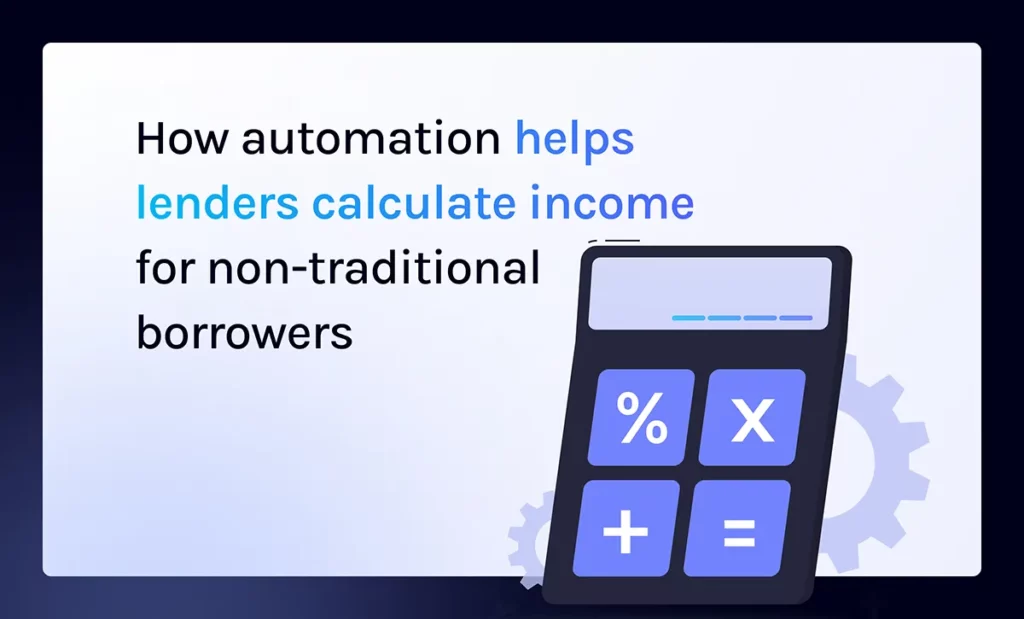This website uses cookies so that we can provide you with the best user experience possible. Cookie information is stored in your browser and performs functions such as recognising you when you return to our website and helping our team to understand which sections of the website you find most interesting and useful.
How automation helps lenders calculate income for non-traditional borrowers

In the U.S., lending decisions have typically relied on credit scores and traditional income verification methods.
While the process works in some instances, underwriting that relies heavily on credit scores favors traditional borrowers while limiting lenders’ view of prospective borrowers with non-traditional or complex income profiles.
To put it simply, lenders may be overlooking viable borrowers by not fully understanding the intricate financial profiles of applicants with diverse income. As loan denials increase, these oversights could restrict potential prospects for both financial institutions and potential customers seeking loans.
By leveraging document automation, lenders can integrate different variables — from bank statements, revenue and expenses to debt and transaction types — into the decision-making process and calculate income for complex borrowers with confidence.
Standardizing calculations for borrowers of all types
One of the biggest hurdles lenders grapple with is inconsistency that appears in manually figuring out what counts as income, especially with borrowers from different employment backgrounds. Automated income calculations, complete with tagging features, help standardize income assessments for all types of employees, eliminating discrepancies.
By introducing automated document capture, financial institutions can effortlessly transform disparate and unstructured information into organized and structured data. This not only simplifies the verification process but also provides lenders with a comprehensive view of borrowers’ financial health.
By aggregating bank statements and other essential data feeds, lenders can obtain a clear snapshot of borrowers’ cash flow. This holistic view is particularly important when dealing with applicants with multifaceted income profiles, such as freelancers, entrepreneurs or consultants.

Funding more loans, more confidently
With the help of cash flow analytics, lenders can delve deeper into the intricacies of a borrower’s cash inflow and outflow patterns, enabling them to identify the nuances of seasonality in cash flow, measure unconventional income sources and accurately gauge debt capacity.
Moreover, by recognizing and categorizing recurring transactions, lenders can more precisely predict the borrower’s financial behavior in the long run and pinpoint the risk of default with a higher degree of accuracy, leading to more confident lending decisions.
This approach not only boosts lenders’ confidence but also ensures that the cost of processing an application remains minimal, striking a balance between thorough evaluation and efficiency.
Creating efficiency in non-traditional income calculations
Non QM-lender Deephaven Mortgage often services customers with complex borrower profiles who have been locked out of the GSE market due to certain standardized requirements like non-W-2 income or short credit histories.
To efficiently service these borrowers, Deephaven partnered with Ocrolus to automate its bank statement analysis and obtain a more accurate calculation of an applicant’s income and cash flow.
By partnering with Ocrolus to automate their income verification and bank statement analysis, Deephaven can now calculate real income within minutes, saving more than two hours of underwriters’ time per application.
Ocrolus income calculations for non-traditional borrowers
Faced with tighter standards and fluctuating market demands, lenders are increasingly challenged to balance efficiency and responsible risk management with the financial needs of a growing pool of complex borrowers.
Catering to this diverse pool of borrowers demands more than just traditional verification methods. Ocrolus enables lenders to efficiently and accurately calculate and verify income for a variety of use cases, including both traditionally and non-traditionally employed applicants.
For example, bank statements stand as testament to an individual’s financial activities. For self-employed individuals, whose income might not fit the conventional mold, these statements are invaluable.
Ocrolus automatically extracts bank statement data into a structured format, reducing the need for manual entry and validation. This not only streamlines the verification process but also ensures accuracy – a critical consideration when assessing financial health of complex borrowers.
Ocrolus cash flow analytics offers a wide array of financial data formats and provides a consistent output schema, regardless of the data source. This enables more nuanced cash flow analysis and risk modeling while enabling lenders to accommodate the widest possible range of borrowers.
The modern lending landscape is changing every day, with a growing pool of borrowers that require more nuanced assessment methods than traditional underwriting criteria.
As the lines between traditional and non-traditional employment blur, lenders must equip themselves with tools that enable them to make informed decisions.
By integrating automation and advanced analytics into their income verification and decision-making processes, lenders can more thoroughly and accurately evaluate these complex borrower profiles.
This ensures a more comprehensive understanding of an applicant’s financial health and optimizes the application review process, making it both efficient and cost-effective. By embracing automation and analytics, lenders can expand their horizons, fund more loans and contribute to a more inclusive financial ecosystem.
Book a demo to learn how Ocrolus can help you assess complex borrow profiles with confidence with automated cash flow lending analysis.
Key takeaways:
- Traditional lending decisions, which primarily rely on credit scores and standard income verification methods, often overlook borrowers with non-traditional or complex income profiles.
- Automated document capture, cash flow analytics and structured data extraction from bank statements allow for a comprehensive view of a borrower’s financial health, facilitating more informed lending decisions.
- By embracing document automation and cash flow risk analysis technology, lenders can confidently assess a wider range of borrowers, including those with complex income profiles.





